Chapter Six—
Musical Connoisseurship
Principles of Attributions and Associations
Because a large majority of the compositions in SPB80 are anonymous, the challenge of identifying composers of anonymous compositions is hard to avoid. If this is a task that most scholars of fifteenth-century polyphony encounter sooner or later, it involves problems that are seldom enumerated. We proceed from premises usually left in the unarticulated realm of scholarly and musical intuition. What are the components of a successful attribution? What are the benefits and risks of naming a composer for an anonymous work? Art historians have honed their awareness of the conceptual problems as a century of art connoisseurs in and out of academia have expounded on their methods in print, and by a generation of scholarly, if rancorous, debate about the relative merits of "connoisseurship"—"the comparison of works of art with a view to determining their reciprocal relationships"—and a more historical or iconological approach to art history.[1]
A musicologist who hazards an opinion about the composer of an anonymous Mass faces several issues different from those encountered by an art historian offering a judgment about the hand of an unattributed altarpiece. Perhaps the most obvious difference is that an expert
[1] The classic statements of principle are Bernard Berenson, Rudiments of Connoisseurship: Study and Criticism of Italian Art (although the essay "Rudiments of Connoisseurship" was published in 1902, Berenson wrote it in 1894. I have quoted his definition from p. 122); Max Friedländer, On Art and Connoisseurship ; and Jakob Rosenberg, On Quality in Art: Criteria of Excellence, Past and Present .
opinion in music has very little impact on the monetary value of the object in question. There are no musical galleries or auction houses that stand to gain or lose large sums depending on the verdict. While this difference is not inconsiderable either in terms of the pressures or temptations that it contributes to the evaluation, it is important primarily because it raises a point that has always separated art and music: Paintings cost more than the written artifacts of a musical composition. Because art has commanded a high price and has not lacked for willing buyers, the (now diminishing) tradition of the great collectors has encouraged a century of expert viewers to develop their skills. Berenson's career depended equally on his own native talents and the patronage of an eager collector, Isabella Stewart Gardner. And because of its greater monetary worth, art, unlike music, has inspired not only stylistic imitators but forgers. Connoisseurs of art must therefore contend with distinguishing a real Rembrandt from a forgery; that is not at all the same magnitude of problem as trying to differentiate the work of a composer or artist from that of a student or emulator.
Art connoisseurs also deal with another more pervasive problem: Art deteriorates and must be restored. Restoration, no matter how careful, inevitably substitutes one form of deterioration for another; in Étienne Gilson's formulation, "There are two ways for a painting to perish: the one is for it to be restored; the other is for it not to be restored."[2] Music undeniably undergoes an aural restoration in performance, even if this performance takes place in the mind of the scholar, and performer and audience are one and the same individual. But while a Mass of Palestrina needs a re-creative interpretation, Palestrina's original artistic lines—his notes—by and large remain, something that art restorers in the nineteenth century often did not respect.[3] Even when we have two substantially different versions of a work, as with Faugues's Missa L'homme armé , at the very least we possess two versions altered by contemporaries, and quite possibly the composer had a hand in both. In cases of scribal alteration common in the manuscript copies of the fifteenth century, the magnitude of change seldom compares to the alterations affected by time, weathering, and the heavy-handed "im-
[2] Étienne Gilson, Painting and Reality , 108.
[3] Regarding alterations to Leonardo's Last Supper and the Mona Lisa , see ibid., 344, n. 28.
provements" of art restorers. There is a qualitative difference between the re-creative role of a performer (or restorer) and the creative decisions made by the original composer or artist.
It matters as well that the means of production for a painting and a composition differed greatly in the Renaissance. Painters created in workshops; thus, depending on the fee and the stipulations in the contract, the leader of the workshop would take responsibility for the entire conception of his work but in its execution contribute anything from the entire work to as little as the faces only, leaving the figures, buildings, and landscape to his assistants. Domenico Ghirlandaio accepted a commission for San Francesco di Palco in Prato that stipulated he was "to draw the Madonna and four saints and paint the heads"; and Signorelli signed a contract in Orvieto to paint the faces and also the upper halves of the figures.[4] The closest musical composition would come to such a group effort are works in which one composer added one or two voices to an already completed chanson. A composer of a Mass generally took much more complete responsibility for his work than the artist of an altarpiece.
All of these points complicate the task of identifying an anonymous artist as opposed to a composer. They obscure or diminish the contribution of the original hand. Yet among the advantages enjoyed by an art connoisseur, the first and most considerable is the relative accessibility of art. Even paintings in need of cleaning and mending can be viewed easily. To study an art work one need only stand before it, or have access to a photograph. It is no accident that the first great modern connoisseur emerged at a time when photography had become a viable tool. Berenson made tremendous use of photographs in his work, and he was the first to do so. The "fototeca" has long since been a standard reference institution. Whether in person or once removed via photograph, an art work creates its own global effect.
For many scholars and virtually all of the amateur audience, the global effect of music from any era demands a performance, and not just one but several. But recordings can only partially fulfill the same function as photographs. They make an extended exposure possible, but they do so for very few older works. Most anonymous composi-
[4] Hannelore Glasser, Artists' Contracts of the Early Renaissance , 73 and 76. She discusses this question in the section on "The Artist's Obligations," 72-92.
tions in need of study will never receive a commercial recording.[5] For this reason the minor oeuvres of minor Tuscan artists are far better known and appreciated as works of art than the majority of the major efforts by musical masters such as Du Fay, Busnois, and Josquin. The musicological equivalent of a photograph must therefore be a score. But a library of scores can approximate a fototeca only for scholars capable of deriving a "global impression" from a transcription. Only the ability to sight-read a score and hear the parts in one's imagination makes possible the variety of readings that art historians get from photographs, everything from quick scans of entire works to selective and close studies of detail. Thus while photographs began to provide assistance to art connoisseurs almost a century ago, musicologists interested in surveying the works of a generation of composers have had a comparable resource only since the widespread publication of transcriptions that began in earnest after World War II.
Connoisseurship, as defined by Berenson, "is based on the assumption that perfect identity of characteristics indicates identity of origin—an assumption ... based on the definition of characteristics as those features that distinguish one artist from another."[6] An anonymous work of art is first examined for those features that are most similar to a particular school and then, on closer inspection, for more telling resemblances to particular artists of the school in question. Having thus narrowed the field, the aims are reversed, so that the connoisseur now hunts for stylistic differences between the anonymous artist and the most likely candidates. Berenson evaluated the many parts of the human body, finding some particularly apt to reveal the individual style of an artist—ears and hands—and some not—the cranium, chin, and overall structure and movement of the body. Likewise landscapes and the folds of clothing provide helpful tests, while architecture, color, and chiaroscuro do not. Each feature in the anonymous work must be tested, making allowances for the relative age of an artist and for the artist's stylistic consistency.[7] While Berenson placed great store in the
[5] Computer technology that allows one to transcribe a work and to produce simultaneously a score and a "recording" for the first time will make it possible to hear the works that remain unrecorded.
[6] Berenson, Rudiments of Connoisseurship , 122.
[7] Ibid., 144-47.
"bony lobe" of an ear by Perugino and the aristocratic hands of Van Dyke, it is on the entire range of evaluations that a secure attribution depended.
Recent critics of art connoisseurship have posed two alternative models for producing an attribution, which I here cast in terms of music: "This Mass is by Josquin because it displays such and such aesthetic qualities" is not the same as saying "This Mass is by Josquin because certain evidence proves that it was composed by Josquin des Prez," a statement that makes no claims about aesthetic properties. These critics reject the former position because they deny the possibility of "proof of authorship in the object itself." The only acceptable means of attributing a work of art for them is "to establish the history of its production."[8] Such a history exists in documents—in the contract for a work of art, an archival payment to a composer, or a letter from a patron that specifically mentions the newly composed Mass by title. Manuscript attributions, if consistent, provide another means of documentation; although, conversely, conflicting attributions by contemporary scribes pose a particular type of problem, a problem that art connoisseurs do not face.
But the opposing models as formulated above oversimplify and thus misrepresent the position of stylistic evidence. What is meant by aesthetic "proof" is never defined, as if it were something objectifiable. Proof in this sense is of course illusory. Attributions, as Max Friedlàn-der long ago put it, "cannot be proved or disproved. And mistakes are only recognized as mistakes when they wither and die. Here the only criterion of truth is that it should be fruitful."[9] An attribution is a hypothesis. Like a good hypothesis, a good attribution includes elements of value apart from the ultimate validity of the attribution; that is, a good attribution should reveal something about the construction of the anonymous work, and also about the style of the artist or composer to whom the attribution is made, that will stand even if the attribu-
[8] I am paraphrasing Gary Schwartz, "Connoisseurship: The Penalty of Ahistoricism," 201-6; and Nelson Goodman, "Art and Authenticity," 93-114. For recent defenses, see David Ebitz, "Connoisseurship as Practice," 207-12; and Sydney Freed-berg, "Some Thoughts on Berenson, connoisseurship, and the History of Art."
[9] Max Friedlànder, From Van Eyck to Bruegel , ix, cited in David Ebitz, "Connoisseurship as Practice," 209.
tion is later disproved. Indeed, a good attribution will contain stylistic insights that may one day assist someone intent on disproving the attribution.
Of Berenson's principles, perhaps the most useful for dealing with anonymous music is the necessity of identifying and testing as many stylistic criteria as possible. Any argument based on one or two criteria is weak, because while a composer may have distinct musical traits, no single aspect of an individual style is unique. Faugues certainly has a tendency to repeat the music of one Mass text with a second and even third text elsewhere in the Mass, but neither is he the only composer to do so, nor do all his Masses show this trait. One can replicate this statement for Josquin's canons, Ockeghem's lengthy lines, and Obrecht's parallel sixths and tenths. No motive, no cadence formula, and no combination of clefs or mensural signs appear only in the music of one composer. Even pronounced national features—British, for example—do not always appear only in the music of British composers. The quintessential British figure, the cadence formula from the 1420s and 1430s first identified by Charles Hamm and invoked by many since, turns up in later works by Continental composers such as Caron (Ex. 1). Thus the more diverse aspects of a composer's personal voice that can be identified, the stronger the attribution.
Of musical traits two pose special challenges because of their ubiquity and the obvious constraints on originality: cadences and motives. Perugino in painting an ear had an inexhaustible supply of human models. Du Fay in composing a contrapuntal line had a very different range of possibilities, limited as all modal and tonal composers are to the seven notes of a diatonic scale. Yet this disparity is not so great as one might suppose. Berenson valued ears precisely because artists tended not to vary this portion of the anatomy, despite the many available models; conversely, despite the limited choices of pitches, there are other factors that make the possibilities for identifying characteristic cadences and motives strong.
Cadential patterns are stereotypical because of the prescribed options for closing on a unison, octave, or fifth; however, composers have cadential tendencies not only in how they approach a particular scale degree rhythmically as well as melodically but also in the frequency of cadences, in the likelihood a cadence may be reigned or avoided, in
EXAMPLE 1. Caron, Missa Jesus autem transiens , Christe, ram. 40-42

the variety of scale degrees chosen for a cadence, and in the manner in which voices proceed after a cadence. Lanoy not only cadences more often than Ockeghem, he cadences on the modal final with a much greater frequency; and Caron and Busnois, in addition to their other similarities, both have a penchant for a particular type of Phrygian cadence (discussed in chapter 8), a type Du Fay avoided.
Regarding motives, there is first of all a question of definition. In broadest terms, a motive is any series of notes imbued with meaning. Meaning can be assigned musically through repetition (either within a composition or between different compositions), whether literal or varied, or through structural function (beginning, middle, or end of a phrase); and, as was normal during this quintessentially vocal era, notes become meaningful through association with a text, a type of referential meaning explored in chapter 10.
Like any signifier of meaning, motives can be presented straightforwardly or imbedded less recognizably within the (musical) text. By adding ornamental notes and varying the rhythm, or through more complex alterations such as inversion or retrograde, composers could transform or disguise motives beyond the limits of recognition. The vast range of possibilities found in polyphonic settings of chant and monophonic secular songs makes this clear. In what remains the most insightful investigation of fifteenth-century musical styles, Edgar Sparks repeatedly comments on the motivic liberties composers enjoyed, noting a mid-century "disinclination to state the same idea twice in the same way." Especially in the decades before the Busnois generation, composers were "restrained only by the necessity of giving the [cantus firmus] notes a position of some prominence in the melody line."[10]
For the purposes of making attributions, motivic variety may present less of a problem than motivic commonality. To paraphrase the title of a cautionary study about how scholars should treat watermarks:
[10] Edgar Sparks, Cantus Firmus in Mass and Motet 1420-1520 , 62-63.
Motives are twins. That is to say, finding a like motive in two works is no guarantee that the motives came from the same mind. Numerous examples of head motives shared by different composers exist. As an example of the extreme to which a single motive could proliferate, I have compiled in Appendix 5 a list of works written between circa 1430 and 1470 with the motive d-f-e-a' (or a transposition, including transpositions to a major mode). Almost all of these works place the motive at the beginning, usually in the upper voice (unless otherwise indicated), or at the start of a subsection. My list of eighty-one citings is without a doubt incomplete.
In order to attempt an organization that might aid in the tracing of significant relationships between occurrences of the motive in different works, I have grouped the motives into separate categories based on how they continue: The first group contains citations that lead immediately to a descent (Ex. 2c), the second of motives that cadence on the top note "a" before proceeding (as in the Puyllois Agnus II in Ex. 2g), the third of motives that continue by ascending, and the fourth of motives that continue unpredictably. This motive appears at the beginning often movements of Masses copied in SPB80 (marked "sp" in Appendix 5). The popularity of the motive among English composers is noteworthy, as is the much greater prevalence of the motive in Masses than in chansons or motets. In its minor-mode form, by far the most common, it is not at all a pattern characteristic of chant beginnings.[11]
Yet as watermarks are important tools when used with care, so too are motives. Even the ubiquitous d-f-e-a' motive can be used to demonstrate a connection between two or more works when it appears as one of a group of motives shared by other works. The greater the number of motives found in common among two works, the closer the ties between them. This is as valid for motivic clichés as it is for unusual gestures. A motive with a distinctive contour could always be copied by an emulator, and popular ideas are not less important for identifying a particular style. The question is not whether a musician used commonplace ideas, but how. A composer's individual style is in large measure defined by how clichés are integrated into a melodic line, how often they are used in sequence, imitatively, and so forth.
[11] John Bryden and David Hughes, An Index of Gregorian Chant , 2:271, lists only one chant, an uncommon offertory verse, with the same sequence of pitches.
This is as true for Ockeghem and Obrecht than as for Bach and Vivaldi, or for improvisations as for written music.
One benefit of positing a composer for an anonymous work that should not be overlooked is simply that an attribution brings an unknown work to the fore; it forces a reexamination of what has been understood previously about a composer's style as well as the styles of his contemporaries. From this benefit come others: If the arguments are musically sound, they can increase our ability to relate musical styles to developments in other arts. The process of stylistic reexamination can lead to a revision of what is understood about a composer's biography, particularly for composers for whom little archival data exists. It can have important historical implications regarding not only the development of regional styles but also the extent of music patronage at a particular church or court. Indeed, part of the credibility of an attribution lies in the (usually unexamined) credibility of its biographical implications. In this study I explore the possibility that the attribution of anonymous Masses can contribute evidence to arguments for the presence in Rome of composers whose employment there is not securely documented.
In music, as in art, there are degrees of attribution. Aside from claiming that a single composer should be recognized as the creator of an anonymous Mass, it is also possible and very worthwhile to demonstrate extensive connections between works—whether motivic, structural, or conceptual—as a means of demonstrating some level of association between composers. This differs from the familiar artistic designation "school of ..." because there is no claim for control on the part of an eminent colleague or senior composer. An argument for association is in a sense an attribution to an artistic milieu. One makes an assertion about a composer's stylistic circle. The biographical information that can come from demonstrating relationships between works is significant because musical resemblances can imply some degree of contact between composers.
In order to attribute a Mass to a particular composer, say Josquin, it is essential not only to be as familiar as possible with the Masses securely attributed to Josquin but also with his motets, his secular music, and as much music by other composers as possible. While Josquin's Masses will reveal his formal and mensural tendencies in dividing and setting the Mass text, his motets and chansons will help significantly to
define his melodic style. To an extent as yet not fully realized, there is often little to distinguish a composer's melodic habits in his chansons from those in his Masses. And a familiarity with the music of Josquin's contemporaries is necessary to distinguish what in his music may be considered typical of his style, on the one hand, and what is common practice. An attribution in which there is no indication that the scholar has done anything more than compare an anonymous work with those firmly in the canon of the desired composer will be inherently less convincing than one that rests visibly on a broad knowledge of several composers.
In the discussions of Masses that follow in this chapter, my goal is not attribution but association. In the first example all but one of the Masses have secure attributions; the exception is the Missa that Charles Hamm has previously attributed to Barbingant. In addition to Hamm's arguments, Barbingant's handling of counterpoint, rhythm, imitation, and phrasing as I understand them are very consistent with the music of this Missa , even if the melodic style is ten to fifteen years more modern. The discovery of a group of Masses with substantive motivic ties provides a useful precedent for the second example of Mass associations, simply because it shows that strong musical connections between works need not imply an authorial relationship. While the biographical import of the associations is suggestive, the musical identities are not as close as in the attributions made in succeeding chapters.
Le Rouge, Faugues, Barbingant, Puyllois
Two Masses in SPB80 have extensive motivic connections with Masses preserved in other Italian manuscripts. The Missa So ys emprentid by Le Rouge and the Missa of Barbingant are part of a complex that also includes Faugues's Missa La basse danse and Johannes Puyllois's Missa .[12]
[12] I accept the attribution of this Mass to Puyllois. It has been questioned by Curtis, "Jean Pullois and the Cyclic Mass or a Case of Mistaken Identity." Motivically it has much in common with chansons and motets of Puyllois and Horlay (as shown below), the composer to whom Puyllois is linked in EscB. Margaret Bent also doubts Curtis's conclusion that this Mass has English origins ("Trent 93 and Trent 90: Johannes Wiser at Work," 92). For the spelling of "Puyllois," I follow Pamela Starr, "Music and Music Patronage at the Papal Court, 1447-1464," 167-75.
The correspondences proceed movement by movement, pairing successive head motives in the manner of a paraphrase; sometimes the order of motives is altered, as when the Patrem of Faugues's Missa La basse danse begins with a motive related to the Et in terra by Le Rouge.
The many resemblances between the Masses in this complex are detailed in Tables 15 and 16, and also in Examples 2 and 3. Table 15 views the shared motives from the standpoint of how they relate to Le Rouge's Missa So ys emprentid , first in a composite listing, then itemized one Mass at a time. Asterisks mark motives that appear with the same text (for the purposes of this table and the next, the separate Kyrie and Agnus sections are considered to be different texts). The Faugues and Barbingant Masses have approximately the same number of motives in common with the Le Rouge Mass, each with more than twice the number of similarities found in the Puyllois Missa . Counting only those motives that appear with the same texts, the remarkable ties between the Masses by Le Rouge and Faugues involve the Patrem, Et incarnatus, Pleni, Benedictus, and Agnus II; these overlap slightly with the six beginnings common to Le Rouge and Barbingant: the Christe, Et in terra, Laudamus te, Patrem, Sanctus, and Agnus II.
Some of these motivic similarities between Le Rouge, Faugues, and Barbingant are shown in Example 2. Normally they involve two voices at the beginning of a section; only Example 2e is from a conclusion. In Example 2h the motivic resemblance is also harmonic: this is the only section of the Agnus to begin on a rather than d in both Masses. At the start of the Qui sedes, Faugues also introduces the same imitative motive that begins the second half of Le Rouge's chanson Se je fayz dueil (Ex. 2i), a resemblance discussed in chapter 10.
A slightly different picture emerges from Table 16, which compares the other Masses to Barbingant's Missa . Barbingant has equally strong resemblances to the Masses by Le Rouge and Puyllois, with ten and nine correspondences respectively. Most movements in the Barbingant Mass start with a motive that also begins the same section of one of these two Masses. Thus Barbingant's Kyrie I shares its head motive with the Kyrie I by Puyllois (Ex. 3a), the Et in terra with the Le Rouge Et in terra (Ex. 2b), and the Patrem with the Le Rouge Patrem; the Sanctus and Agnus both relate to the motive that begins the Puyllois Patrem (the comparisons are in Exs. 3b and c). Because of these ties to
EXAMPLE 2. Motivic comparison of Faugues, Missa La basse danse , Le Rouge, Missa So ys emprentid , and Barbingant, Missa
EXAMPLE 2A . (i) Faugues, Christe, min. 1-5; (ii) Le Rouge, Cum sancto, ram. 1-3; (iii) Barbingant, Christe, min. 1-4
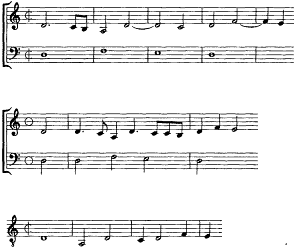
EXAMPLE 2B . (i) Faugues, Patrem, mm. 1-6; (ii) Le Rouge, Et in terra, min. 1-4; (iii) Barbingant, Et in terra, mm. 1-5
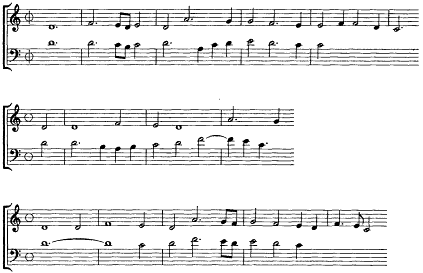
(continued )
EXAMPLE 2 (continued )
EXAMPLE 2C . (i) Faugues, Crucifixus, mm. 1-7; (ii) Le Rouge, Et in spiritum (SPB80), Et incarnatus (Tr90), mm. 1-3; (iii) Barbingant, Christe, mm. 1-7
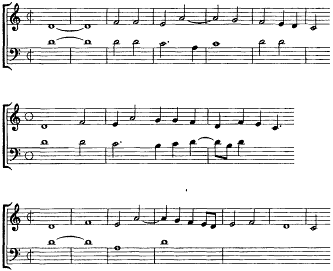
EXAMPLE 2D . (i) Faugues, Pleni, min. 1-5; (ii) Le Rouge, Pleni, mm. 1-3; (iii) Barbingant, Benedictus, mm. 1-7
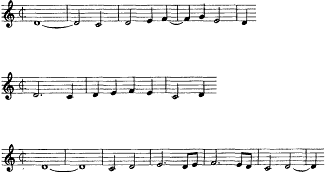
(continued )
EXAMPLE 2 (continued )
EXAMPLE 2E . (i) Faugues, Pleni, mm. 16-20; (ii) Le Rouge, Pleni, mm. 25-30

EXAMPLE 2F . (i) Faugues, Benedictus, mm. 1-9; (ii) Le Rouge, Benedictus, min. 1-4, 5-6
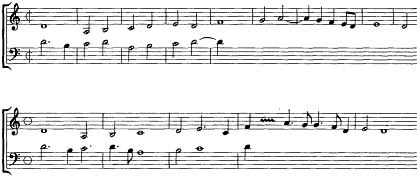
(continued )
EXAMPLE 2 (continued )
EXAMPLE 2G . (i) Faugues, Agnus II, mm. 1-4; (ii) Le Rouge, Agnus II, mm. 1-5; (iii) Barbingant, Agnus II, mm. 1-3; (iv) Puyllois, Missa , Agnus II, mm. 1-4
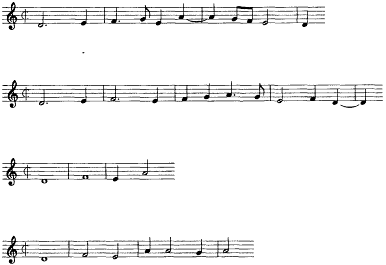
EXAMPLE 2H . (i) Faugues, Agnus I, min. 1-3; (ii) Barbingant, Agnus III, min. 1-4
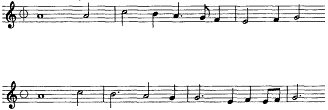
EXAMPLE 2I . (i) Faugues, Qui sedes, mm. 9-15; (ii) Le Rouge, Se je fayz dueil , part 2
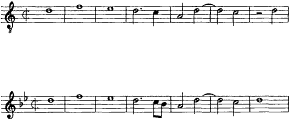
Barbingant and Puyllois, Le Rouge could not have been solely dependent on Faugues. There is also evidence that Faugues was not exclusively indebted to Le Rouge: While all of the motives that Faugues shares with Barbingant's Missa are also present in Le Rouge's Mass, Faugues is more likely than Le Rouge to have motives with the same text set by Barbingant.
A partial measure of the many similarities between the Puyllois Missa and the Masses by Barbingant and Le Rouge is shown in Example 3. The head motive in the Puyllois Mass does not remain constant. After the Kyrie I, which begins d-f-e-c and then winds its way up to a', Puyllois transforms the motive in various ways, either by preceding the four opening pitches with f (Ex. 3b) or d-f (Ex. 3c) or by following them with a descent to the lower a (Ex. 3e). In the Sanctus the motive that begins on d and then descends from f to a is varied from one section to the next. Most of the motivic permutations that occur in the Puyllois Missa also occur in the Barbingant Missa , in essentially the same sequence. But while Puyllois spreads his throughout each movement of the Mass, Barbingant concentrates them in the Kyrie, Sanctus, and Agnus (the other movements having stronger resemblances to the Le Rouge Mass).
All four Masses in this cluster relate motivically at the head motive of the Agnus II (Ex. 2g). Despite the commonplace character of this ubiquitous d-f-e-a' motive, the coincidence of variants on this motive at the same text, in four Masses with numerous other motivic ties, is less likely to be a matter of chance. Among all the many other instances of this motive in Masses, only in the fifth Naples Missa L'homme armé does it occur at the Agnus II, there transposed to begin on G.
Who followed whom? Faugues and Barbingant both seem to depend heavily on Le Rouge. Stylistically Faugues's Mass is certainly later than the Missa So ys emprentid . In terms of length it extends far beyond the dimensions of that by Le Rouge. The entire Kyrie I, Christe, and Kyrie II of the Missa So ys emprentid last for forty-six breves of tempus perfectum , as opposed to forty-six breves in tempus perfectum diminutum for just the Kyrie II in Faugues's Mass. Barbingant's Missa , equally linked to Le Rouge and Puyllois, is transmitted in the second layer of SPB80 and in Tr89, with repertoires closer in date to those of CS51 and Tr91, the sources of the Missa La basse danse . Of the
EXAMPLE 3. Motivic comparison of Puyllois, Missa , Barbingant, Missa , and Le Rouge, Missa So ys emprentid
EXAMPLE 3A . (i) Puyllois, Kyrie I, mm. 1-4; (ii) Barbingant, Kyrie I, mm. 1-5; (iii) Puyllois, Et in terra, mm. 1-5
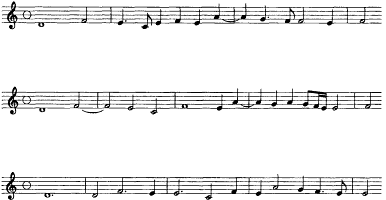
EXAMPLE 3B . (i) Puyllois, Qui sedes, mm. 10-15; (ii) Barbingant, Agnus I, mm. 1-4
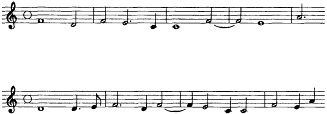
EXAMPLE 3C . (i) Puyllois, Patrem, mm. 1-4; (ii) Barbingant, Sanctus, mm. 1-5
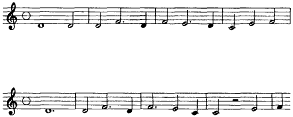
(continued )
EXAMPLE 3 (continued )
EXAMPLE 3D . (i) Puyllois, Domine Fill unigenite, min. 1-4; (ii) Le Rouge, Osanna I, ram. 1-4
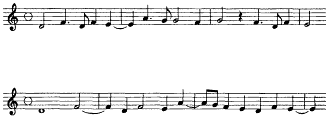
EXAMPLE 3E . (i) Puyllois, Sanctus, mm. 1-4; (ii) Le Rouge, Sanctus, mm. 1-3; (iii) Puyllois, Kyrie I, mm. 14-17; (iv) Barbingant, Pleni, mm. 11-13
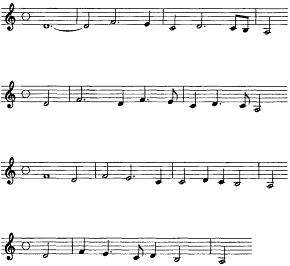
Masses by Le Rouge and Puyllois, that by Puyllois seems to be the older, but this is by no means certain. These four Masses therefore apparently fall into two chronological pairs, an early one of Puyllois and Le Rouge, and a slightly later one (perhaps fifteen years) of Faugues and Barbingant.
A previously unrecognized secular source of the Puyllois Missa sug-
gests an additional link to Le Rouge and Barbingant. Although Puyllois may have cited more than one chanson in his Missa , he draws extensively on Puisque je suis infortunée by Horlay, a composer closely associated with Puyllois in the chansonnier Escorial.[13] The chanson is particularly evident in the Sanctus. From the opening motive (Ex. 4a) through the mid-point of the chanson, each phrase is present in the Missa . Examples 4b and c show consecutive phrases of the chanson and Sanctus with cadential counterpoint that is at times identical. The me-dial cadence with its falling third in the superius then follows in the chanson (Ex. 4d). Both voices appear in the Qui tollis and at the end of the Qui ex patre, altered there to include a cadence on d rather than e. The bass melodic figure, marked "x," and the rhythms are identical. And the Qui tollis has a simplified version with both voices in duple meter.[14] In the Kyrie II there is a noncadential

Textually the Horlay chanson is close both in theme and rhyme to the chansons Terriblement suis fortunée and Pour une suis desconfortée . In each the poet blames his lack of fortune on the rejection of a lover, with rhyming verses on the word abandonée :
Puisque je suis infortunée, (line 1)
Et de m'amour abandonée ... (line 2)
Pour une suis desconfortée... (line 1)
Pour ce que suis abandonée ... (line 3)
Terriblement suis fortunée ... (line 1)
M'a de tous poins abandonée ... (line 6)
While Terriblement suis fortunée is well known as the source of a Mass by Barbingant, Pour une suis desconfortée is the preferred French text to Frye's English ballade So ys emprentid .[15] Thus Puyllois, Barbingant, and
[13] Martha K. Hanen, The Chansonnier El Escorial IV. a. 24 , I: 80-81, and below, p. 225 n. 35.
[14] On the strength of the sharped c in the chanson, a ficta alteration in the Mass is reasonable.
[15] On the sources and texting, see Leeman Perkins and Howard Garey, The Mellon Chansonnier , 2:370-72; and Isabel Pope and Masakata Kanazawa, The Musical Manuscript Montecassino 871 , 567-68.
EXAMPLE 4. Motivic comparison of Horlay, Puisqueje suis infortunée and Puyllois, Missa
EXAMPLE 4A . (i) Horlay, mm. 1-3; (ii) Puyllois, Sanctus, mm. 1-4
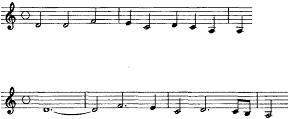
EXAMPLE 4B . (i) Horlay, mm. 8-10; (ii) Puyllois, Sanctus, mm. 12-17

EXAMPLE 4C . (i) Horlay, mm. 11-16; (ii) Puyllois, Sanctus, mm. 17-21
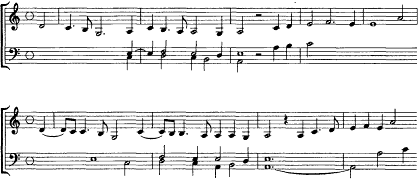
(continued )
EXAMPLE 4 (continued )
EXAMPLE 4D . (i) Horlay, ram. 14-19; (ii) Puyllois, Qui ex Patre, ram. 34-38; (iii) Puyllois, Qui tollis, mm. 37-47
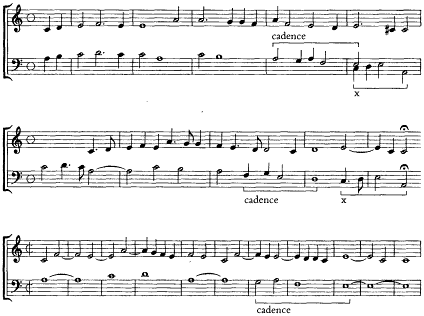
EXAMPLE 4E . (i) Horlay, mm. 25-28; (ii) Puyllois, Kyrie II, mm. 16-20

(continued )
EXAMPLE 4 (continued )
EXAMPLE 4F . (i) Horlay, mm. 1-3; (ii) Puyllois, Kyrie, mm. 1-4
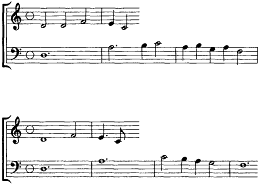
Le Rouge may each have written Masses based, at least in part, on chansons with a related message. That they probably did so within a few years of each other—on stylistic and paleographic grounds they have been dated circa 1450—increases the likelihood of some conscious emulation, an emulation also suggested by the other motivic ties between the Masses by Le Rouge and Puyllois and later by Barbingant and Faugues.[16]
From a purely musical standpoint, the motivic similarities between these four Masses demonstrate vividly that composers could emulate one another without reference to the tenor. While composing his Mass on a dance tune presented in the tenor, Faugues cited motives from
[16] Rob Wegman, "Petrus de Domarto's Missa Spiritus almus and the Early History of the Four-Voice Mass in the Fifteenth Century," 301, dates the Puyllois Missa ca. 1445 on the basis of its appearance in Tr87. However, Bent suggests that the Tr87 copy of this Mass was made from that in Tr93 on the basis of "errors shared between the two copies, and some deteriorations in the otherwise neater Tr 87 copy" ("Trent 93 and Trent 90," 90, n. 28). Saunders has dated the Tr93 copy at "1451, 1452" ("The Dating of Trent 93 and Trent 90," 73). That the Tr87 version could be later concurs with Gary R. Spilsted's hypothesis that the Tr87 fascicles that include the Mass, largely empty, were to "allow for further repertory to be added as it was needed" ("The Paleography and Musical Repertory of Codex Tridentinus 93," 56). He dated the watermark of this paper broadly at "ca . 1450 to ca . 1470" (75).
the Le Rouge Missa So ys emprentid in the contrapuntal voices, as did Barbingant. Without a doubt this kind of citation had textual meaning.
Caron and the Anonymous Missa, SPB80, Folios 122-29
An anonymous Mass in layer 1 of SPB80 has compelling ties to Masses by Caron. Initially the most striking similarity is the high degree of motivic correspondence. The head motive was a familiar one to Caron. Example 5 juxtaposes the head motive as it appears in the Kyrie and Agnus to statements in the Missa Clemens et benigna , the Missa Thomas (transposed), and what might be the beginning of the missing Agnus for the Missa Sanguis sanctorum ,[17] as well as in Masses of Ockeghem, Bedyngham, and Domarto and in Dunstable's motet Salve scema sanctitatis . In these as in other instances tallied in Table 17, the motive often occurs in one section of the Sanctus. Of all the motives shown in Example 5 and listed in this table, those by Caron consistently show the rhythmic pattern found in the Missa . Although it is not included here, the Pleni of the third Naples Missa L'homme armé is rhythmically close to the Missa Sanguis sanctorum fragment.
This motive doubtless relates to a widely popular motive of the same period, a motive with possible Marian associations that had a special appeal to Dunstable and other British composers and also to Du Fay (Table 18). Example 6 has a representative sampling, beginning with three appearances at Et in terra: this SPB80 Missa , Caron's Missa Sanguis sanctorum , and Du Fay's Missa Sancti Antonii Viennensis . The Patrem of Bedyngham's Missa Deuit angouisseux and a Benedictus by Sovesby provide precedents for the rhythm used by Du Fay and Caron. Among the many examples of this motive with a Marian text are two motets by Dunstable, his Sancta Maria, non est tibi similis and Sub tuam protectionera , and the anonymous Missa Regina coeli laetare in Tr91. Marian interpretations of the Song of Songs doubtless influenced the application of the motives in Tables 17 and 18 to the settings of
[17] This fragmentary superius line is in Ver755, fol. 42v, immediately after the conclusion of the Sanctus.
EXAMPLE 5. Comparison of Sanctus motive in Anonymous, Missa (SPB80, fols. 122-29) with occurrences in works by Caron, Ockeghem, Bedyngham, Domarto, and Dunstable
EXAMPLE 5A . (i) Missa , Kyrie I; (ii) Missa , Agnus I
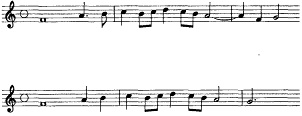
EXAMPLE 5B . (i) Caron, Missa Clemens , Benedictus (transposed from G); (ii) [Caron], Missa Thomas , Pleni (transposed from G); (iii) Caron, Missa Sanguis , Agnus I?
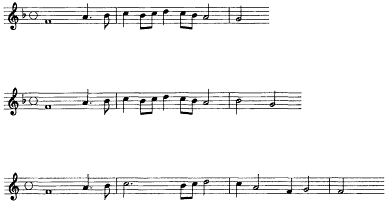
(continued )
Descendi in ortum meum, Quam pulchra es , and Quae est ista by Dun-stable, Hothby, and the anonymous composers. And in secular settings a Marian association presumably also lies behind Busnois's use of the motive at the beginning of his chanson Ja que line and as counterpoint midway through Je ne puis at the text "Noble femme."
EXAMPLE 5 (continued )
EXAMPLE 5C . (i) Ockeghem, Missa Mi mi , Pleni; (ii) Bedyngham, Missa (Tr88), Sanctus; (iii) Domarto, Missa, Et in terra; (iv) Dunstable, Salve scema sanctitatis
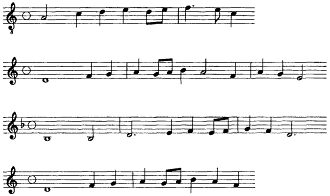
But in addition to some of the same fashionable motives in the SPB80 Missa and Masses of Caron, there are others less common. The Christe motive turns up in the Missa Accueilly , Osanna I (Ex. 7; other settings by Caron are shown in chapter 8, Ex. 31), a movement that also follows the same sequence of cadences as the Christe: a, c, and then f. Additionally, the Benedictus relates motivically to two Mass movements—the Missa Accueilly , Agnus I, and the third Naples Missa L'homme armé , Agnus II (Ex. 8)—and also to a Caron chanson, Pour regard doeul . The chanson connection, discussed in chapter 10 and shown there in Example 67, links not only the first motives but also an interior phrase of the Benedictus to part 2 of the chanson. Likewise, the Agnus II of the Missa is related to another Caron movement, the Missa L'homme armé , Agnus II, and another one of the Naples L'homme armé Masses, the Benedictus of the sixth Mass. This network of motivic relationships also includes both voices of the Ockeghem three-voice Missa , Agnus II.
Motivic resemblances to Caron extend to interior motives. The SPB80 Missa features a sequential pattern used by more than one
EXAMPLE 6. Comparison of Marian motive in Anonymous, Missa (SPB80, fols. 122-29) with occurrences in other fifteenth-century compositions
EXAMPLY . 6A . (i) Missa , Et in terra; (ii) Caron, Missa Sanguis , Et in terra; (iii) Du Fay, Missa Sancti Antonii , Et in terra (transposed from C)
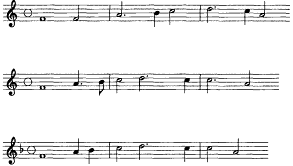
EXAMPLE 6B . (i) Bedyngham, Missa Deuil angouisseux , Patrem; (ii) Sovesby, Benedictus (Aosta, fols. 252v-53)

EXAMPLE . 6C . (i) Dunstable, Sub tuam protectionem ; (ii) Anonymous, Quam pulchra es (Tr90, fol. 342v); (iii) Busnois, Ja que li ne
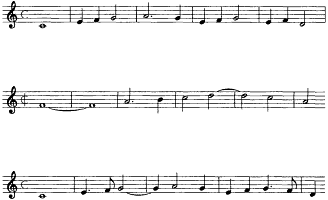
EXAMPLE 7. Motivic comparison of (a) Anonymous, Missa (SPB80, fols. 122-29), Christe; and (b) Caron, Missa Accueilly , Osanna I
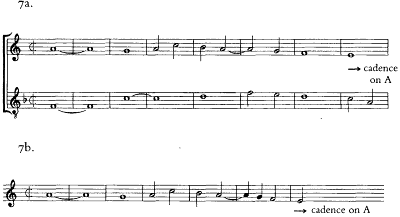
EXAMPLE 8. Motivic comparison of (a) Anonymous, Missa (SPB80, fols. 122-29), Benedictus; (b) Anonymous, Missa L'homme armé (Naples 3), Agnus II; and (c) Caron, Missa Accueilly , Agnus I
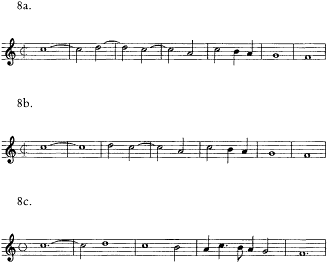
EXAMPLE 9. Comparison of counterpoint in (a) Caron, Missa L'homme armé , Crucifixus; and (b) Anonymous, Missa (SPB80, fols. 122-29), Agnus II
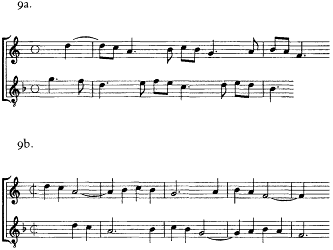
composer in the 1460s. In the Agnus II the imitative form of this sequence compares closely to the same descending line in the Crucifixus of Caron's Missa L'homme armé (Ex. 9).[18] It also appears, although not in imitation, in the Agnus II of the Ockeghem Missa just cited because of the resemblance between the opening gestures. Caron, as many of his generation, was also fond of F-major triadic figures such as those in the Patrem and Qui tollis of the Missa . This sort of trumpetlike fanfare could easily bring harmonic movement to a momentary stasis, as in the Missa , Patrem, and Caron's Corps contre corps (Ex. 10).[19]
Last, the conflicting signature present throughout the Mass,

[18] See also Philippe Caron, Missa Accueilly , Et resurrexit, mm. 8-9.
[19] There are similar passages in O vie fortunée and Cent mille escus . Caron's Madame qui tant est mon cuer also has an extended "C-major" triadic passage, min. 49-54.
EXAMPLE 10. Comparison of counterpoint in (a) Anonymous, Missa (SPB80, fols. 122-29), Patrem; and (b) Caron, Corps contre corps
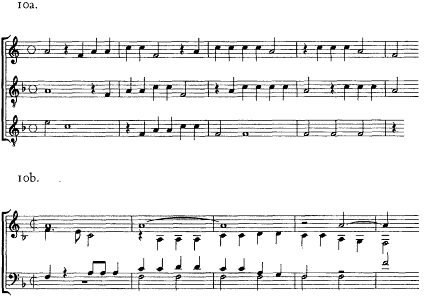
O vie fortunée, Pour regard doeul, Rose plaisant, Se doulx penser , and Vous n'avez point .
Despite all of these similarities, this is not likely a Mass by Caron but by someone who influenced him. There are too many important ways in which it departs from the conventions of Masses securely attributed to Caron. This Mass is not a tenor Mass but has a motto for the Kyrie, Sanctus, and Agnus, and there are no independent settings of either the second Osanna or the third Agnus, as there are in all known Caron Masses. Further, instead of duet beginnings, all movements begin with all voices, a difference that may be excused because we have no Masses for three voices attributed to Caron for comparison. Its mensural usage is, for the Kyrie, Gloria, and Credo, much like that of the Missa Sanguis sanctorum . The Sanctus, however, goes its own mensural way at the Osanna I by its use of Ø. All of Caron's Masses use either tempus perfectum or tempus imperfectum diminutum for the Osanna I
(see Table 23 on p. 398). Perhaps most of all, and difficult to demonstrate in a musical example or two, the rhythms are too straightforward to be from the hand of Caron, whose predilection for syncopated lines inspired the highly irregular bar lines that render the complete edition of his works so difficult to use.
Bedyngham or one of his compatriots warrants consideration. Of the attributes described above, Bedyngham also used static harmonies on F triads in his Tr88 Missa in the Confiteor (mm. 185-88), while in the compositions of John Plummet—for example his Anna mater matris —they are particularly common. And the same conflicting key signature occurs in several works of Power and Bedyngham, usually with the identical clef combination of the SPB80 Missa (C1, C3, C3), the same high ranges, and the same degree of voice crossing, as in Bedyng-ham's Missa Deuil angouisseux and his Benedicamus Domine (Tr88).[20]
The motives from the Missa listed in Tables 17 and 18 occur frequently in English works, as does the following motive, found throughout the SPB80 Missa (Ex. 11). In Stone's Tota pulchra es and in the Missa attributed in Strahov to the little-known British composer Standly, the motive fulfills a similar function as a kind of contrapuntal filler. In contrast, when Du Fay handled it, as in the canonic duet that appears in both the Ave regina coelorum and Ecce ancilla Masses, the contrapuntal texture is more complex. In later decades, as discussed in chapter 9, Martini turned to this motive reflexively. Last, if the Christe motive shown above in Example 7 is close to Caron, it is contrapuntally closer to Bedyngham (Ex. 12). Together with its tenor it appears as the second phrase of Bedyngham's Myn hertis lust , with texts that could not be more rhetorically appropriate for the Christe: "Which are the guide unto my perfect life" [Which is the guide unto my par-
[20] The fauxbourdon cadence in the SPB80 Missa , Et in spiritum, mm. 55-61, occurs virtually note for note in the anonymous Kyrie in Tr88 (fols. 26v-27), mm. 27-32 of the Christe (see the edition in Rebecca Gerber, "The Manuscript Trent, Castello del Buonconsiglio, 88: A Study of Fifteenth-Century Manuscript Transmission and Repertory, 2:3-7). This Kyrie appears to be related to the Missa angouisseux (though I agree with David Fallows that this Kyrie is not characteristic of Bedyngham's style ["Johannes Bedyngham," 348]). But because fauxbourdon cadences are so prescribed, the identity of three contrapuntal lines for six breves is less significant than it would be for other types of cadential counterpoint.
EXAMPLE 11. Motivic comparison of (a) Anonymous, Missa (SPB80, fols. 122-29), Patrem, mm. 12-15; and (b) Standly, Missa , Patrem, mm. 9-13
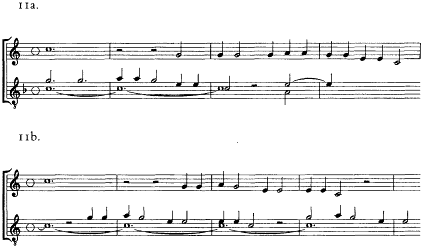
EXAMPLE 12. Bedyngham, Myn hertis lust , mm. 8-11

faite liffe] and "Whom I serve with attentive heart" [Whom that y serve with herte atentiffe].[21] As demonstrated shortly, when Caron sets this phrase he does so in a different harmonic and contrapuntal context.
The SPB80 Missa stands as a musical hybrid, the likely product of an English composer working on the Continent or a Continental composer with pronounced insular tendencies.
[21] The translation is by Howard Garey (Perkins and Garey, The Mellon Chansonnier , 2: 386).